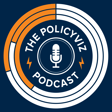
Jeremy Ney Visualizes American Inequality
Jeremy is the author of American Inequality, a biweekly newsletter that uses data visualization to highlight U.S. inequality topics and to drive change in communities. His work has been published in TIME, Bloomberg, and the LA Times. He was a dual-degree masters student at MIT Sloan and the Harvard Kennedy School and was formerly a macro policy strategist at the Federal Reserve. He now works at Google and lives in Brooklyn.
Episode Notes
Jeremy on Twitter | Op-ed in Time
American Inequality newsletter: americaninequality.substack.com
Federal Reserve Bank of New York
Technology and Disability: The Relationship Between Broadband Access and Disability Insurance Awards
Some coverage of the map:
Related Episodes
Episode #228: Ethan Mollick
Episode #224: Pieta Blakely and Eli Holder
Episode #191: Sarah Williams

